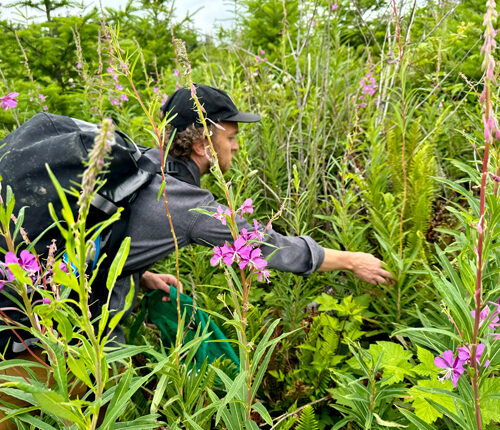The fewer invasive, toothy northern pike swimming closer to Grand Coulee Dam, the less worry for salmon downstream, which likely would become dinner for northern pike.
The Confederated Tribes of the Colville Reservation, Spokane Tribe of Indians and the Washington Department of Fish and Wildlife reported during a Northwest Power and Conservation Council Fish and Wildlife Committee meeting on Tuesday a dramatic decrease in northern pike numbers due to years of monitoring and suppression tactics.
Over the past year, the Colville Tribe has counted fewer than one northern pike per gillnet on Lake Roosevelt, said Holly McLellan, aquatic invasive species manager with the Colville Tribe. Gillnets are one way to capture northern pike.

Biologist Travis Rehm pulls in a northern pike with a gillnet. CREDIT: Courtney Flatt
“While this information is promising, only time will tell if the downward trend will continue,” McLellan said.
Northern pike once looked like nothing but bad news for Washington’s Lake Roosevelt, said Stacy Horton, Washington policy analyst with the council.
The aggressive fish also could spell devastation for salmon, which people in the Northwest prefer to eat rather than the bony northern pike. Currently, giant concrete dams stand between northern pike and salmon.
Biologists worry about the havoc northern pike could cause if they make it past Grand Coulee and Chief Joseph dams, which block salmon from the upper part of the Columbia River.
So far, suppression efforts, including gillnetting, electrofishing and an angler reward program, have helped prevent northern pike from reaching the free-flowing area of the Columbia River.
Researchers suspect the northern pike in Lake Roosevelt migrated from the Clark Fork river system in Montana.

Northern pike are voracious. Because their mouths open so wide, they can eat a lot of fish other predators can’t. CREDIT: Courtney Flatt
The fish eat anything in their path. Biologists have spotted northern pike chomping down on ducks and bats. In Lake Roosevelt, biologists have found redband trout and wild kokanee in the stomachs of northern pike.
Surveys from 2021 show northern pike suppression has kept the invasive fish mostly in the upper half of the reservoir, which is not near Grand Coulee Dam.
“That means we’re having an effect at keeping these fish from moving downstream and reducing abundances in the reservoir,” said Chris Donley, Region 1 Fish Program manager for the Washington Department of Fish and Wildlife.
However, northern pike are spawning in the Columbia River near Colville and the unincorporated areas of Evans and Gifford. Northern pike also are spawning the Kettle River, a tributary of the Columbia, McLellan said.
Of the fish still found in the reservoir, most range in age from less than a year to 1 year old, Donley said. A few fish are 2 to 3 years old, he said, which means there aren’t many large northern pike remaining in Lake Roosevelt because of successful suppression efforts.
However, northern pike reproduce at early ages, he said, which creates a challenge.
Since 2015, the Colville and Spokane tribes and the state have removed 17,994 northern pike, McLellan said, including 8,800 female northern pike that carried up to 442 million eggs.
In addition, an angler reward program helps harvest northern pike, paying $10 per northern pike head. Since 2017, the program has paid out $33,790, McLellan said.
In 2020, the reward program saw a large increase in payouts, McLellan said, totalling $11,220.
“The world shutdown and gave people lots of free time to go fishing,” she said, referring to job closures because of Covid-19 shutdowns.
Shutdown aside, the number of northern pike anglers catch has decreased each year, McLellan said, likely because of suppression efforts.
As a part of monitoring efforts, the Colville Tribe tracks 50 sites in the Upper Columbia River for traces of northern pike environmental DNA, or eDNA, which is DNA from an organism that researchers can detect in samples of air, water or soil. The tribe monitors sites from the Okanogan River to the Canadian border, McLellan said.
In 2021, eight eDNA sites, mostly in the lower part of the Lake Roosevelt reservoir and Banks Lake, researchers no longer found northern pike DNA at those eight sites, she said.
While it will be difficult to eradicate northern pike, said Donley, the suppression effort appears successful.
However, suppression efforts will need to continue for the long-term, Donley said, who has worked for the department for more than 25 years.
“I think this lasts the remainder of my career. Unfortunately, the person who comes after me is going to inherit it as well,” Donley said of the northern pike invasion.
In addition, Donley said, the state has monitored a northern pike invasion at Lake Spokane, a 50-mile reservoir on the Spokane River upstream of Lake Roosevelt. Most of the northern pike remain in the upper part of the Lake Spokane reservoir, he said.
Northern pike have been found in Lake Spokane since the 1970s. However, biologists have noticed the fish spawning more successfully, potentially due to climate change or a change in water use, Donley said.
“If we don’t get our arms around this issue in Lake Spokane, it’ll just continue downstream into Lake Roosevelt,” he said, advancing the northern pike closer to Grand Coulee Dam.




















